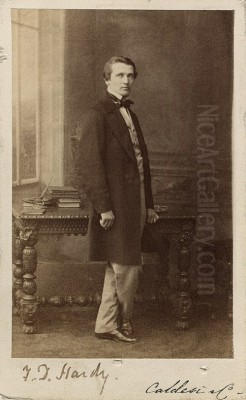
Frederick Daniel Hardy stands as a significant figure in 19th-century British art, celebrated for his intimate and meticulously detailed depictions of domestic life. A prominent member of the Cranbrook Colony, Hardy's work offers a window into the interiors of Victorian homes, particularly those in rural settings. His paintings, often imbued with warmth, narrative interest, and gentle sentiment, captured the imagination of his contemporaries and continue to resonate with audiences today. Born into an artistic family, Hardy carved his own path, moving from music to painting and establishing a distinct style characterized by careful observation and technical skill.
Early Life and Artistic Beginnings
Frederick Daniel Hardy was born on February 13, 1827, in Windsor, Berkshire, England. He was the third son of George Hardy, a musician at the Private Band of Music for Queen Adelaide, George IV, and Queen Victoria, who was also a talented amateur artist himself. Frederick's mother was a respected piano teacher, whose pupils included the daughters of Queen Victoria and Queen Alexandra. This environment, steeped in both music and visual art, undoubtedly shaped the young Hardy's sensibilities.
Initially, following in his father's footsteps, Frederick pursued music. At the age of seventeen, he enrolled at the Royal Academy of Music in Hanover Square, London, to study singing and musical theory. However, his passion ultimately shifted towards the visual arts. He abandoned his musical studies and turned his focus to painting, receiving guidance and instruction from his elder brother, George Hardy (1822-1909), who was already establishing himself as an artist specializing in similar domestic scenes.
Hardy's dedication to his new craft quickly bore fruit. In 1851, at the age of 24, he made his debut on the London art scene, exhibiting his works for the first time at both the prestigious Royal Academy of Arts and the British Institution. This marked the beginning of a long and successful exhibiting career. Between 1851 and 1898, Hardy would exhibit an impressive total of ninety-three paintings at the Royal Academy alone, a testament to his consistent output and the esteem in which his work was held.
The Cranbrook Colony: A Community of Artists
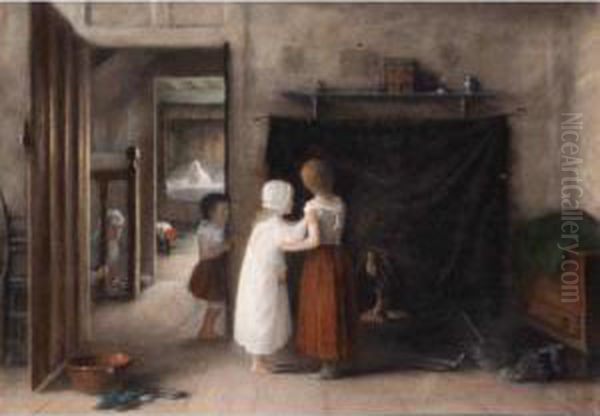
A pivotal moment in Hardy's life and career occurred in 1852. In that year, he married Rebecca Cussons. Shortly after their marriage, the couple moved from the bustling environment of London to the quiet, picturesque village of Cranbrook in the Weald of Kent. This move was not merely a change of scenery; it placed Hardy at the heart of what would become known as the Cranbrook Colony, an informal but influential group of artists who settled in the village from the 1850s onwards.
The Cranbrook Colony was not defined by a formal manifesto but by a shared sensibility and subject matter. The artists were drawn to the village's rustic charm and sought to depict scenes of everyday rural and domestic life, often with a nostalgic or sentimental tone that contrasted with the rapid industrialization transforming much of Britain. They favoured detailed realism, drawing inspiration from 17th-century Dutch and Flemish genre painters, and focused on narrative clarity in their compositions.
Frederick Daniel Hardy became a central figure in this artistic community. His neighbour and close friend was Thomas Webster (1800-1886), an established Royal Academician known for his charming scenes of village life and childhood, who had moved to Cranbrook earlier. Webster became a mentor figure to the younger Hardy, and the two artists shared a deep mutual respect and artistic affinity. For a time, they even shared studio space in a house on Cranbrook's High Street, fostering a close working relationship.
Other key members associated with the Cranbrook Colony included George Bernard O'Neill (1828-1917), another close friend and occasional collaborator of Hardy's, known for his similarly detailed domestic scenes; John Callcott Horsley (1817-1903), Webster's brother-in-law, a versatile painter and illustrator perhaps most famous today for designing the first commercially produced Christmas card; and later, Augustus Edwin Mulready (1844-1904), who painted scenes of London street life but was also associated with the Colony's aesthetic. Hardy's own brother, George Hardy, also spent time working in Cranbrook.
Artistic Style, Themes, and Influences
Frederick Daniel Hardy's artistic style is characterized by its meticulous attention to detail, careful rendering of textures, and skillful handling of light, particularly within interior settings. He specialized in genre painting, focusing on the depiction of everyday life, primarily within the cottages and homes of rural Kent. His canvases often feature cozy kitchens, parlours, and workshops, populated by families, children, and local villagers engaged in simple, relatable activities.
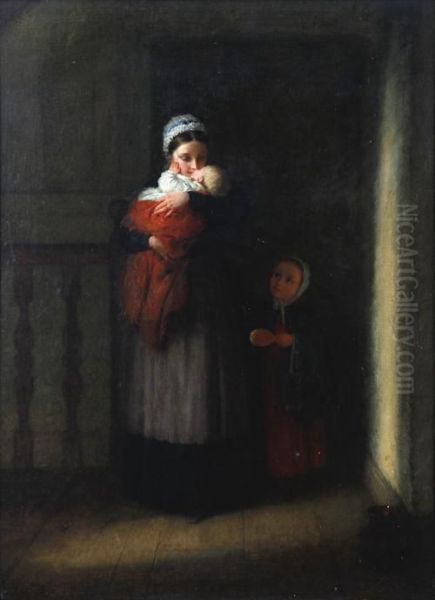
His technique involved precise drawing and the application of smooth, carefully blended layers of oil paint, creating a high degree of finish. This detailed realism invites viewers to closely examine the objects and figures within the scene, enhancing the narrative quality of his work. The influence of 17th-century Dutch masters, such as Johannes Vermeer, Pieter de Hooch, and Gabriel Metsu, is often noted in Hardy's treatment of light, composition, and his elevation of domestic subjects. Like these earlier masters, Hardy found beauty and significance in the quiet moments of daily existence.
A recurring motif in Hardy's work is the hearth or fireplace. As highlighted in the provided snippets, this element often serves as the focal point of the composition, symbolizing the heart of the home, family unity, warmth, and security. In paintings like The Sweep (c. 1864), the fireplace frames the interaction between the family and the young chimney sweep, highlighting social dynamics. In other works, it provides the primary light source, casting a warm glow over the figures and objects, reinforcing the sense of domestic intimacy and comfort. The hearth could represent safety and hope, or sometimes, as in The Leaky Roof (1865), its inadequacy could underscore themes of hardship and vulnerability.
Hardy's paintings frequently feature children, depicted with sensitivity and charm. Whether playing games, helping with chores, or simply observing the adult world, the children in his works add a layer of innocence and emotional appeal. His portrayal of family life, while often idealized, also captures the nuances of relationships and daily routines in the Victorian era.
Key Works and Recognition
Throughout his long career, Frederick Daniel Hardy produced numerous paintings that garnered critical acclaim and popular appreciation. His consistent presence at the Royal Academy exhibitions ensured his visibility within the London art world, and his works were sought after by collectors.
One of his most celebrated paintings is Playing at Doctors, completed in 1863 and now housed in the Victoria and Albert Museum, London. This charming work depicts a group of children mimicking adult behaviour, with one 'doctor' attending to a 'patient' doll, while others look on. The scene is rendered with Hardy's characteristic detail, capturing the textures of clothing, furniture, and toys within a sunlit cottage interior. It exemplifies his skill in portraying childhood innocence and narrative detail.
The Sweep (also known as The Chimney Sweep), painted around 1864, is another significant work. It shows a young, soot-covered chimney sweep standing hesitantly in a comfortable middle-class kitchen, receiving payment or perhaps a comforting drink from the lady of the house, while children observe. The painting touches upon themes of social class and child labour, albeit presented within a typically warm and detailed domestic setting.
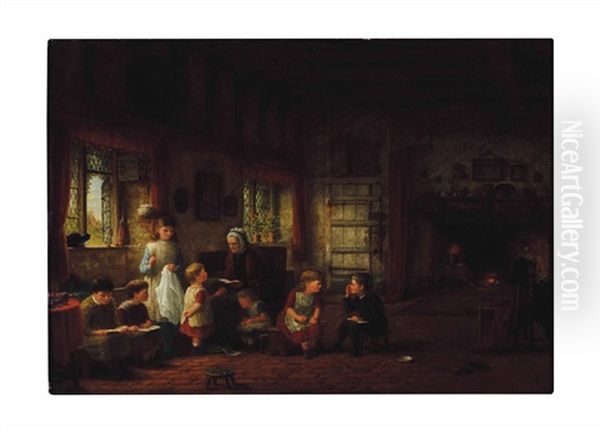
The Leaky Roof (1865) presents a more poignant scene. It depicts a family huddled together in a sparsely furnished cottage interior, anxiously watching water drip from the ceiling into strategically placed bowls during a storm. The painting conveys a sense of vulnerability and domestic hardship, showcasing Hardy's ability to evoke empathy through his detailed portrayal of everyday struggles.
Hardy also collaborated with his friend and fellow Cranbrook artist, George Bernard O'Neill. A notable example is The Surprise, where Hardy is credited with painting the detailed interior of the cottage, while O'Neill painted the figures. This collaboration highlights the close artistic bonds within the Cranbrook Colony and the artists' shared stylistic approach.
His work Two Children was exhibited at the London International Exhibition of 1872, further cementing his reputation. Hardy's paintings were not confined to the Royal Academy; they were also shown at the British Institution and various other galleries, ensuring a wide audience for his depictions of Victorian domesticity. His success allowed him to build a substantial house and studio in Cranbrook, reflecting his standing as a respected and commercially successful artist.
Relationships and Wider Artistic Context
Frederick Daniel Hardy's artistic journey was shaped by various relationships and the broader context of Victorian art. His initial training came from his elder brother, George Hardy, establishing a familial artistic lineage. His father, George Hardy senior, though primarily a musician, provided an early artistic environment. His cousin, Heywood Hardy (1842-1933), also became a successful artist, known particularly for his paintings of animals, hunting scenes, and 18th-century genre subjects, indicating a strong artistic current within the extended family.
The most significant professional relationship was arguably with Thomas Webster. As neighbours, friends, and fellow artists in the close-knit Cranbrook community, their interaction was profound. Webster's mentorship and shared studio arrangement provided Hardy with invaluable support and artistic exchange during his formative years in the village. Their shared interest in detailed, narrative scenes of rural life cemented the core identity of the Cranbrook Colony.
His friendship and collaboration with George Bernard O'Neill further underscore the collegial atmosphere among the Cranbrook artists. They shared models, props, and likely discussed compositions and techniques, contributing to the cohesive style associated with the group. John Callcott Horsley, another prominent RA member in Cranbrook, added to this network of established artists working in a similar vein.
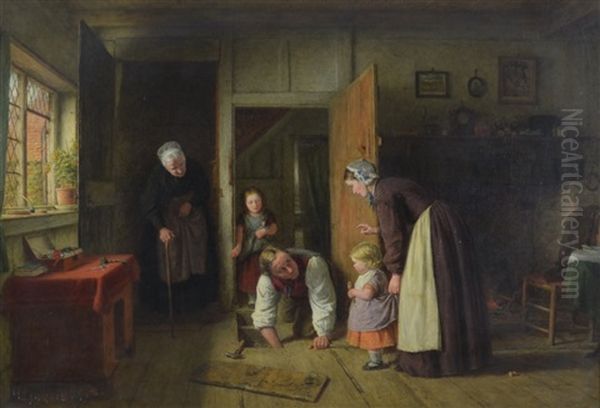
Beyond the immediate Cranbrook circle, Hardy's work can be situated within the broader trends of Victorian genre painting. This was a period when scenes of everyday life, historical anecdotes, and social commentary were immensely popular. Artists like William Powell Frith (1819-1909), famous for large-scale contemporary panoramas such as Derby Day and The Railway Station, captured the bustling public life of the era. Others, like Augustus Egg (1816-1863) in his moralizing triptych Past and Present, explored darker social themes.
Later Victorian artists such as Sir Luke Fildes (1843-1927) and Frank Holl (1845-1888) brought a grittier social realism to genre painting, often depicting poverty and hardship with starkness, as seen in Fildes' Applicants for Admission to a Casual Ward. While Hardy occasionally touched upon themes of hardship (The Leaky Roof, The Sweep), his overall tone remained gentler and more focused on the comforts and sentiments of domesticity, aligning him more closely with the earlier British genre tradition exemplified by Sir David Wilkie (1785-1841), known for his detailed narrative scenes of Scottish life. Hardy's meticulous technique and focus on interior light also perpetually invite comparisons with the Dutch Golden Age masters like Vermeer, de Hooch, Metsu, and Jan Steen.
Later Life and Legacy
Frederick Daniel Hardy continued to live and work in Cranbrook for the remainder of his life, remaining active as a painter well into his later years. He maintained his focus on the domestic genre scenes that had brought him success, refining his technique and exploring variations on his favoured themes. His dedication to his craft and his consistent output contributed significantly to the enduring reputation of the Cranbrook Colony.
He passed away on April 1, 1911, in Cranbrook, Kent, at the age of 84. He left behind a substantial body of work that provides invaluable insight into the domestic interiors and social customs of the Victorian era, particularly in rural England.
Frederick Daniel Hardy's legacy rests on his mastery of the domestic genre scene. As a key member of the Cranbrook Colony, he helped shape a distinct artistic movement that celebrated rural life and traditional values in response to a rapidly changing world. His paintings are admired for their technical proficiency, intricate detail, narrative clarity, and warm, often sentimental, portrayal of family life. While sometimes viewed as idealized, his works capture a specific vision of Victorian England that continues to hold appeal for its charm, intimacy, and historical interest. His paintings are held in numerous public collections, including the Victoria and Albert Museum in London and the Wolverhampton Art Gallery, ensuring his contribution to British art history remains accessible to future generations.
Conclusion
Frederick Daniel Hardy was more than just a painter of pleasant domestic scenes; he was a meticulous craftsman and a sensitive observer of the human condition within the context of the Victorian home. His association with the Cranbrook Colony places him within a significant, albeit localized, movement in British art that championed realism, narrative, and a focus on everyday life. Through his detailed interiors, charming depictions of children, and skillful use of light, Hardy created a body of work that documents and celebrates the intimate sphere of 19th-century domesticity. His paintings endure as compelling examples of Victorian genre art, valued for their technical skill, historical insight, and enduring human warmth.